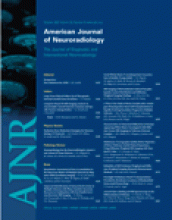Abstract
SUMMARY: We report a case of T1 hyperintense vertebral column metastatic disease in a 24-year-old man with metastatic melanoma. Radiologic work-up revealed multiple lytic vertebral metastases on CT with corresponding T1 hyperintensity on MR imaging. Whereas T1 hyperintensity associated with melanoma has been well documented, to our knowledge, this is the first described case of widespread T1 hyperintense metastatic bone disease. T1 hyperintense bone lesions are virtually always benign. However, correlation with the lesion appearances on other MR imaging sequences and imaging modalities as well as with the clinical history may occasionally suggest otherwise.
The vast majority of T1 hyperintense vertebral column lesions are benign. Spinal column metastatic disease of melanoma origin is not, however, uncommonly encountered. Metastatic melanoma has been demonstrated to produce T1 hyperintense lesions elsewhere in the body either related to the melanin or hemorrhage content. We report the first case in the English literature of metastatic melanoma producing widespread T1 hyperintense vertebral column lesions.
Case Report
A 24-year-old man with no remarkable medical history was admitted after a grand mal seizure. Examination revealed no focal neurology, a left painless axillary mass, several subcutaneous pigmented nodules, and tenderness within the cervical, thoracic, and lumbar spine.
CT of the brain revealed multiple enhancing lesions within the cerebrum and cerebellum, some with high attenuation on the noncontrast study consistent with hemorrhage. CT of the chest revealed large left axillary lymphadenopathy, multiple lung nodules, and multiple subcutaneous nodules. CT of the abdomen revealed multiple low attenuation lesions within the liver and spleen and multiple subcutaneous nodules. CT of the cervical, thoracic, and lumbar spine revealed multiple lytic lesions.
MR imaging revealed multiple T1 hyperintense lesions throughout the cervical, thoracic, and lumbar spine, corresponding to the lytic lesions seen on CT (Fig 1A, -B). In addition, multiple T1 hyperintense subcutaneous and intramuscular nodules were identified (Fig 1B).
A, Sagittal T1 MR imaging. Multiple bone lesions with T1 hyperintensity involve the cervical and thoracic spine, with a pathologic fracture of T6 (T1 turbo spin-echo; TR, 624 ms; TE, 14 ms; field of view, 360 mm; matrix, 448 × 224; number of excitations, 1; section thickness, 4 mm; intersection gap, 0.4 mm; scan time, 1 minute 55 seconds; echo-train length, 5; phase-encoding direction, superior to inferior). B, Parasagittal T1 MR imaging. Multiple lesions with T1 hyperintensity involve the thoracic and lumbar spine, and a T1 hyperintense metastatic nodule is evident in the paraspinal muscles (T1 turbo spin-echo; TR, 624 ms; TE, 14 ms; field of view, 360 mm; matrix, 448 × 224; number of excitations, 1; section thickness, 4 mm; intersection gap, 0.4 mm; scan time, 1 minute 55 seconds; echo-train length, 5; phase-encoding direction, superior to inferior).
Cytologic examination of the left axillary nodes demonstrated clusters of malignant cells, some with heavy pigmentation. Immunoperoxidase stains were positive for markers S-100, HMB45, and Melan-A. These findings were consistent with metastatic melanoma.
Discussion
T1 hyperintense signal intensity on MR imaging in melanoma has been attributed to hemorrhage or melanin.1 Several studies have demonstrated a correlation between T1 shortening and melanin content but a weaker correlation between T2 shortening and melanin content. The increased T1 signal intensity is thought to be the result of the paramagnetic effects of melanin, presumably related to the chelated metal ions or the free radicals known to exist in melanin.2–4
Whereas increased T1 signal intensity in melanoma has been well documented elsewhere, to our knowledge, this is the first case in relation to spinal column melanoma metastases. This has clinical significance for the ability of MR imaging to detect metastatic melanoma spinal column lesions. MR imaging detection in current clinical practice of spinal column metastatic disease is heavily reliant upon detecting such lesions on T1-weighted images.5 Metastatic lesions are well known to generally approach the signal intensity of muscle, and in combination with adult T1 mildly hyperintense background marrow intensity, this results in excellent sensitivity.5 When performing MR imaging in search of metastatic melanoma, given that these lesions may be T1 hyperintense, it therefore seems advisable to perform more than T1-weighted imaging (eg, postgadolinium T1-weighted imaging with fat suppression or short tau inversion recovery), because such lesions may not be evident if the background marrow is of similar intensity to the lesion.
Conclusion
T1 hyperintense marrow lesions are usually benign; however, this case of metastatic melanoma with T1 hyperintense bone lesions demonstrates that it is always prudent to review such lesions on other sequences. When investigating or staging melanoma, careful review for such T1 hyperintense lesions and additional sequences seems warranted.
- Received February 3, 2007.
- Accepted after revision March 5, 2007.
- Copyright © American Society of Neuroradiology








